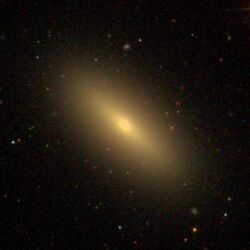Astronomy:NGC 4564
From HandWiki
Short description: Elliptical galaxy in the constellation Virgo
| NGC 4564 | |
|---|---|
 Sloan Digital Sky Survey image of NGC 4564. | |
| Observation data (J2000 epoch) | |
| Constellation | Virgo |
| Right ascension | 12h 36m 27.0s[1] |
| Declination | 11° 26′ 21″[1] |
| Redshift | 0.003809[1] |
| Helio radial velocity | 1142 km/s[1] |
| Distance | 57.2 Mly (17.55 Mpc)[1] |
| Group or cluster | Virgo Cluster |
| Apparent magnitude (V) | 12.05[1] |
| Characteristics | |
| Type | E6[1] |
| Size | ~59,100 ly (18.12 kpc) (estimated)[1] |
| Apparent size (V) | 3.5 x 1.5[1] |
| Other designations | |
| CGCG 70-186, MCG 2-32-150, PGC 42051, UGC 7773, VCC 1664[1] | |
NGC 4564 is an elliptical galaxy located about 57 million light-years away[2] in the constellation Virgo.[3] NGC 4564 was discovered by astronomer William Herschel on March 15, 1784.[4] The galaxy is also a member of the Virgo Cluster.[5][6]
NGC 4564 has an estimated population of 213 ± 31 globular clusters.[7] It is the host of a supermassive black hole with an estimated mass of about 56 million suns (0.56+0.03
−0.08×108 M☉).[8]
On May 2, 1961, a Type Ia supernova designated as SN 1961H was discovered in NGC 4564.[9][10]
See also
References
- ↑ 1.0 1.1 1.2 1.3 1.4 1.5 1.6 1.7 1.8 1.9 "NASA/IPAC Extragalactic Database". Results for NGC 4564. http://nedwww.ipac.caltech.edu/.
- ↑ "Your NED Search Results". http://ned.ipac.caltech.edu/cgi-bin/objsearch?objname=NGC+4564&extend=no&hconst=73&omegam=0.27&omegav=0.73&corr_z=1&out_csys=Equatorial&out_equinox=J2000.0&obj_sort=RA+or+Longitude&of=pre_text&zv_breaker=30000.0&list_limit=5&img_stamp=YES.
- ↑ "Revised NGC Data for NGC 4564". http://spider.seds.org/ngc/revngcic.cgi?NGC4564.
- ↑ "New General Catalog Objects: NGC 4550 - 4599" (in en-US). https://cseligman.com/text/atlas/ngc45a.htm#4564.
- ↑ "The Virgo Cluster". http://www.atlasoftheuniverse.com/galgrps/vir.html.
- ↑ "Detailed Object Classifications". http://ned.ipac.caltech.edu/cgi-bin/NEDatt?objname=NGC+4564.
- ↑ Rhode, Katherine L. (2012). "Exploring the Correlations between Globular Cluster Populations and Supermassive Black Holes in Giant Galaxies" (in en). The Astronomical Journal 144 (5): 154. doi:10.1088/0004-6256/144/5/154. ISSN 1538-3881. Bibcode: 2012AJ....144..154R. http://stacks.iop.org/1538-3881/144/i=5/a=154.
- ↑ Soria, R.; Graham, Alister W.; Fabbiano, G.; Baldi, A.; Elvis, M.; Jerjen, H.; Pellegrini, S.; Siemiginowska, A. (2006). "Accretion and Nuclear Activity of Quiescent Supermassive Black Holes. II. Optical Study and Interpretation" (in en). The Astrophysical Journal 640 (1): 143–155. doi:10.1086/499935. ISSN 0004-637X. Bibcode: 2006ApJ...640..143S. http://stacks.iop.org/0004-637X/640/i=1/a=143.
- ↑ "Other Supernovae images". http://www.rochesterastronomy.org/snimages/snother.html#1961H.
- ↑ "1961H - The Open Supernova Catalog" (in en-US). https://sne.space/sne/1961H/.
External links
- NGC 4564 on WikiSky: DSS2, SDSS, GALEX, IRAS, Hydrogen α, X-Ray, Astrophoto, Sky Map, Articles and images
 |

